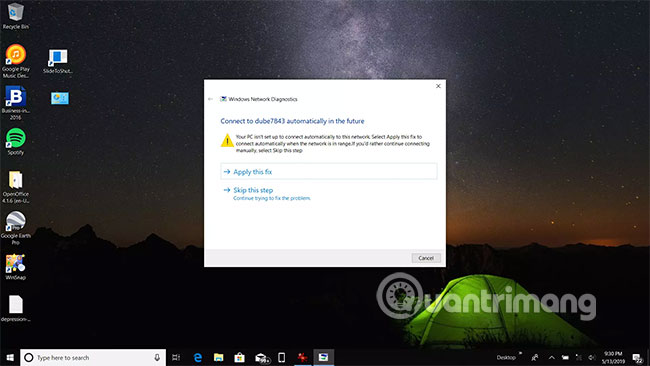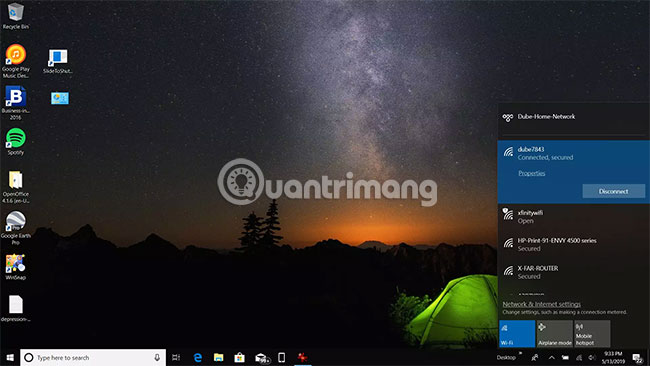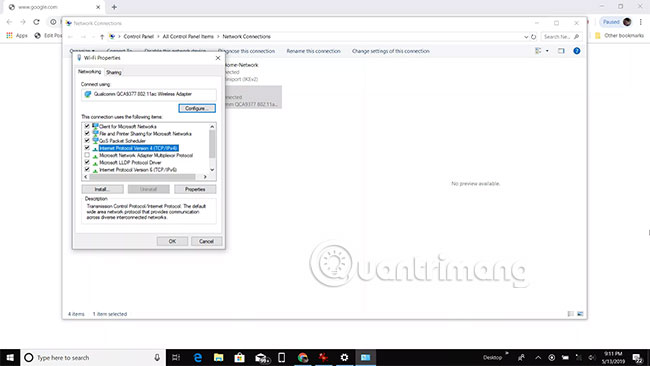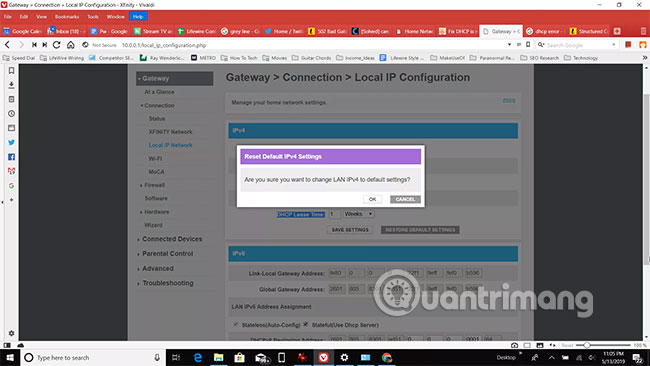What is DHCP error? How to overcome it?
Two things can cause DHCP errors. One is due to configuration on your computer or device, which allows DHCP server to assign IP. The second is due to the configuration of the DHCP server itself.
DHCP error means the server on the network, which provides the IP (Internet Protocol) address to the device, cannot assign your device an IP address.
Find out why and how to fix DHCP errors
- How does a DHCP error occur?
- Troubleshoot problems to handle DHCP errors
- Manually fix DHCP settings
- Fix DHCP error with router settings
How does a DHCP error occur?
Because DHCP settings can disrupt Internet connection, errors can occur in many forms. Finally, the main sign is that you will not be able to access the Internet.
A DHCP error occurs when your DHCP server or router cannot automatically adjust the IP address of the computer or device to join the network.
This often results in a network connection error when you try to access the Internet using a web browser.

What makes DHCP errors difficult is because this error is not always related to DHCP. However, you can confirm whether the DHCP error is the cause of your Internet connection problem in some way.
Troubleshoot problems to handle DHCP errors
The easiest way to fix Internet connection problems is by having Windows automatically fix Internet settings for you. If your DHCP settings are incorrect, Windows will try to fix them.
1. To do this, simply right-click the network connection icon in the Windows taskbar and select Troubleshoot problems .

2. The network troubleshooter will determine any settings that may cause Internet connectivity problems. It will give you the option to apply the proposed fixes. If your DHCP settings cause errors, they will also be fixed. Select Apply this fix to apply any proposed changes.

3. If the fixes automatically work, you will see your network connection working again. Open the web browser and try connecting to the Internet. If it still doesn't work, you'll need to manually edit your DHCP settings.

Manually fix DHCP settings
If the troubleshooter doesn't automatically fix your DHCP installation, you can do this manually.
1. Select the Start menu and click the Settings gear icon. This will open the Windows installation window. Select Network & Internet from the Windows Settings window.

2. This will open the Network Status window. Scroll down and select Change adapter options .

3. This step will display all network adapters configured on your computer. Right-click on the active adapter and select Properties.

4. In the Wi-Fi Properties window, select Internet Protocol Version 4 , and then click Properties.

5. If the option Obtain an IP address automatically has not been selected, select it.

6. Select OK, then click Close to save the new settings. Restart the computer.
This setting allows the DHCP server or router on your network to assign the computer the next available IP address on the network.
If you notice that the Obtain an IP address automatically has been selected, the DHCP error may not be due to the computer's network settings, but caused by the router settings.
Fix DHCP error with router settings
On a regular corporate network, the DNS server manages the IP addresses of devices on the network. All DHCP settings are managed by the IT department, so if you have trouble connecting to the network, you should contact the company help.
However, on the home network, DHCP settings in the router will manage the IP addresses of devices on the network. If you see a DHCP error, you should check the router settings.
To do this, you will need to access your home router as an admin.
Note : The windows system of most major routers is slightly different, but in general you can find the settings described below in menus with similar names.
1. From the main screen of the router, find the Network Settings or Local IP Network window.

2. In the Network Settings window , you will notice some important settings.
- Gateway Address : This is the IP address for the router.
- DHCP Beginning Address : IP starts for the addresses of devices on your network.
- DHCP Ending Address : IP ends for the addresses of devices on your network.
- DHCP Lease Time : The length of time that the device stays the same before they are renewed and changed.
3. The address that starts and ends DHCP must match the router's IP address, except the last number. If these addresses do not match, the router's DHCP settings may have been corrupted or incorrect. Select the Restore Default Settings button if it is available. Select OK to confirm the change of settings.

4. Restart the router and any network device has a DHCP error. After restarting, check if your Internet connection is working.
DHCP errors are not always easy to fix, but by confirming the DHCP settings on both the router and the device on the network, troubleshooting is often simpler.
Hope you are succesful.
You should read it
- What is DHCP or dynamic host configuration protocol?
- How to Install, Configure, and Test Windows Server 2012 R2 Single Subnet DHCP Server
- Set up DHCP server in Windows 2003
- The DHCP vulnerability in Red Hat Linux helps hackers execute remote code
- Which is better DHCP or static IP?
- Use Group Policy Filtering to create a NAP DHCP enforcement policy - Part 1
- Configuration, static DHCP settings on DD-WRT router
- Configure TCP / IP to use DHCP and static IP address at the same time
May be interested
- Configuration, static DHCP settings on DD-WRT router
 dhcp will help us easily set up access via network in the office, home, port - port forwarding ... in the following article, we will guide you how to implement the process. configure dhcp static on the dd-wrt router device, and combine and take advantage of the advantages ...
dhcp will help us easily set up access via network in the office, home, port - port forwarding ... in the following article, we will guide you how to implement the process. configure dhcp static on the dd-wrt router device, and combine and take advantage of the advantages ... - Configure TCP / IP to use DHCP and static IP address at the same time
 to configure your computer to use both dhcp to allocate ip addresses and static ip addresses, follow these steps
to configure your computer to use both dhcp to allocate ip addresses and static ip addresses, follow these steps - Instructions on DD-WRT - Part 1: Static DHCP
 there are many cases where you want your client to receive a consistent or predictable ip address.
there are many cases where you want your client to receive a consistent or predictable ip address. - Install and configure Windows Server 2008 DHCP Server
 before you can use advanced dhcp services, you need to install and configure some basic issues. that is the content we will introduce in the article.
before you can use advanced dhcp services, you need to install and configure some basic issues. that is the content we will introduce in the article. - Learn about DHCP Server Security (part 2)
 in this part 2, we will continue with the effective methods and tools used to enhance the security of the dhcp server.
in this part 2, we will continue with the effective methods and tools used to enhance the security of the dhcp server. - Use Group Policy Filtering to create a DHCP enforcement policy for NAP - Part 3
 in this part 3, i will show you more about policies and see what they do in a dhcp enforcement solution.
in this part 3, i will show you more about policies and see what they do in a dhcp enforcement solution. - Instructions for installing DHCP Role in Windows Server 2012
 dynamic host configuration protocol (dhcp) - dynamic server configuration protocol is the network services that are commonly deployed in the current network environment
dynamic host configuration protocol (dhcp) - dynamic server configuration protocol is the network services that are commonly deployed in the current network environment - 5 ways to overcome Dale Carnegie's fear and anxiety
 here are five of the most effective methods carnegie draws from life experience and knowledge from ancient philosophical research to help people overcome fear and anxiety.
here are five of the most effective methods carnegie draws from life experience and knowledge from ancient philosophical research to help people overcome fear and anxiety. - Transfer DHCP from Windows Server 2000 to 2008
 transfer method dynamic host configuration protocol (dhcp) from microsoft windows nt server 4.0 system to windows server 2008.
transfer method dynamic host configuration protocol (dhcp) from microsoft windows nt server 4.0 system to windows server 2008. - Move DHCP from 2000 Server / Server 2003 to Server 2008
 dhcp is one of two network-based services that help control network behavior (the other is dns).
dhcp is one of two network-based services that help control network behavior (the other is dns).










 What is Fileless Malware?
What is Fileless Malware? What do you know about Windows NT?
What do you know about Windows NT? Switch from base 2 to base 16
Switch from base 2 to base 16 Transfer from base 10 to base 16
Transfer from base 10 to base 16 Switch from base 16 to base 10
Switch from base 16 to base 10 What is OpenAL?
What is OpenAL?